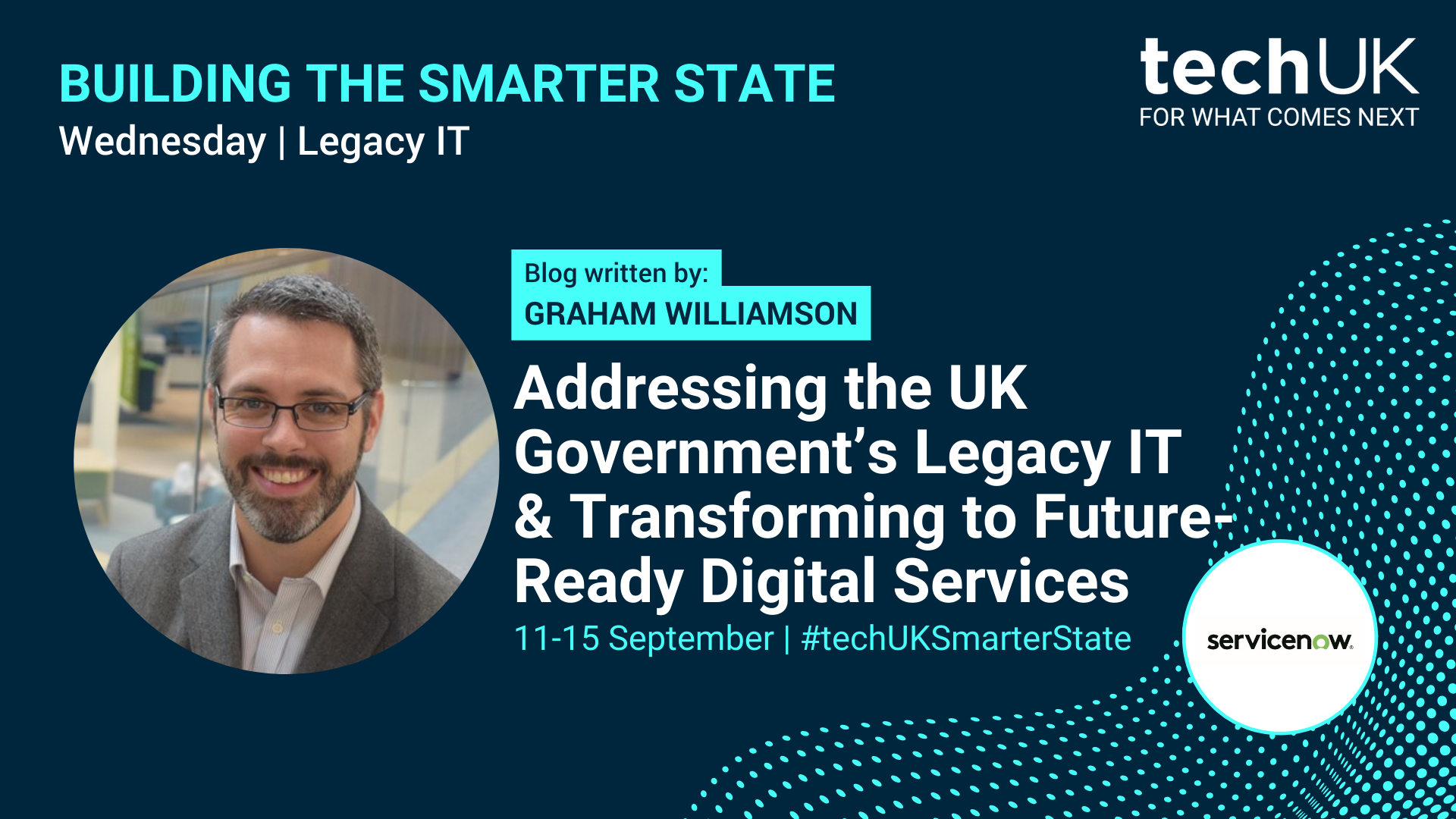ServiceNow: Addressing the UK Government’s Legacy IT & Transforming to Future-Ready Digital Services #techUKSmarterState
Legacy IT is a persistent challenge that organisations across the globe continue to grapple with. The rapid pace of technological advancement and mounting expectation for consumer-grade experience mean that the drag created by legacy is becoming increasingly detrimental to businesses, governments, and not-for-profits alike. Consequences are far-reaching, impacting organisations, their customers, shareholders, broader supply chain, and wider stakeholders.
In global surveys conducted by intelligence and advisory firm IDC, on average over 50% of respondents’ application portfolios were deemed legacy and despite 35% of those legacy applications having experienced some degree of modernisation in recent years, most still failed to shake off their legacy label. Across the UK Government alone, it is estimated that legacy IT presents a £13-22Bn risk for the UK government over the next 3-5 years, costs 50% of annual IT budgets just to keep lights on and is estimated by Central Digital & Data Office (CDDO) to cost circa £6Bn to remediate.
But what is “legacy IT”? CDDO defines "legacy IT" as technology that is now "considered an end-of-life product, out of support from the supplier, impossible to update, no longer cost-effective or now considered to be above the acceptable risk threshold.”
For governments and national infrastructure, legacy IT:
- increases the risk of critical failure
- impedes meeting citizen and employee needs
- prohibits interoperability within and across organisations
- wastes finite resources
Legacy IT presents both a critical strategic risk for governments globally and a critical strategic choice: deploy new services limited by an old architecture or build a new architecture fit for the next generation of services without a lose-lose trade-off between personalisation and security. The challenge for organisation leaders is not only the transformation of the old but also the responsible creation of the new in a manner that avoids the trap of simply replicating antiquated analogue models and missing the opportunity to make future innovative services.
Historically, much effort and expense has been invested in the development of ‘silos of excellence’ within government organisations and functions. However, the experiences that citizens and employees now expect, and the resilience and adaptability government digital services must achieve cannot be provided by disconnected, siloed organisations, processes, data, and IT.
Addressing “Legacy IT” therefore requires a shift in mindset, from focusing on replacing legacy IT components to instead rearchitecting legacy ways of working, enterprise architectures and end-to-end experiences.
We propose that addressing legacy IT within government organisations and across HMG is comprised of three key priorities:
Priority 1 - Ensuring Visibility & Insight: Establishing and maintaining a trusted holistic view of the IT estate (including architecture, business context and value, technical health and currency, and risk) and using this to make data-driven strategic IT management decisions, including potentially how and when to address legacy IT components and risks.
Priority 2 - Driving Transformation & Remediation: Strategising, planning, driving, and delivering the digital transformation of government services and the remediation of legacy IT across departments in a strategic, coordinated, efficient, and effective manner. Collating, managing, and prioritising the myriad of competing demands to ensure focus and effort is applied to the right things, in the right order, with the right resource, using the right approach.
Priority 3 - Creating Future-Ready Digital Government Services: Creating new and improving existing digital government services for citizens and employees that replace legacy ways of working, legacy architectures, and legacy IT components. Creating user-centric, engaging, and empowering services and architectures that flexibly connect organisation and technical silos, overlay or replace legacy IT and complexity, and allow collaboration and automation end-to-end.
Given the complexity and enormity of the task to both remediate the old whilst transforming for the new, we propose that legacy IT is better reframed as “IT risk management” and that taking a data-driven, automated, risk management approach is the key to success.
Data is at the heart of this decision-making and governance: data about the performance and value of existing services; data about the demands and needs of users; data about emerging trends and opportunities; data about the architecture and risk of the existing estate; data about the roadmaps, plans, investments, and motivations of current and future change initiatives.
Without suitable technology and automation, acquisition and accuracy of this data, discovery of risks, and identification of action will be an insurmountable manual effort within each organisation, let alone across organisations. Likewise, automation is critical to enable the scalable aggregation of data from across organisations to CDDO and the dissemination of policy, insights, and actions from CDDO to organisations. Accurate data, technology and automation combined with a staunch risk management approach are the cornerstone of confidence and effectiveness in the management of UK Government legacy IT and the digital transformation of government services.
We have brought our thoughts together in a white paper: Addressing the UK Government Legacy IT Challenge, in which we provide a blueprint for success comprised of data and technology requirements, capabilities and scalable methodology. The white paper is available on ServiceNow's UKI Government microsite with other relevant UK & Ireland public sector customer stories, thought leadership and technical material. We invite and recommend anyone working in or for a Public Sector organisation to explore this site and download the white paper.

ServiceNow is a cloud-based digital transformation and management platform that helps digitise and unify organisations so that they can find smarter, faster, better ways to make work flow, enabling their customers (“citizens”) and employees to be more connected, more innovative, and more agile. ServiceNow is recognised as a leader by Gartner and Forrester across a multitude of capabilities, including low-code application development, IT and enterprise service management, customer service management, risk management, digital process automation and value stream management.

Graham Williamson is Principal Enterprise Architect for UK&I Public Sector at ServiceNow.
From 11 – 15 September techUK is running our annual Building the Smarter State Week in the run-up to the ninth edition of our flagship public services conference, Building the Smarter State, on Wednesday 27 September. Book your tickets here.


